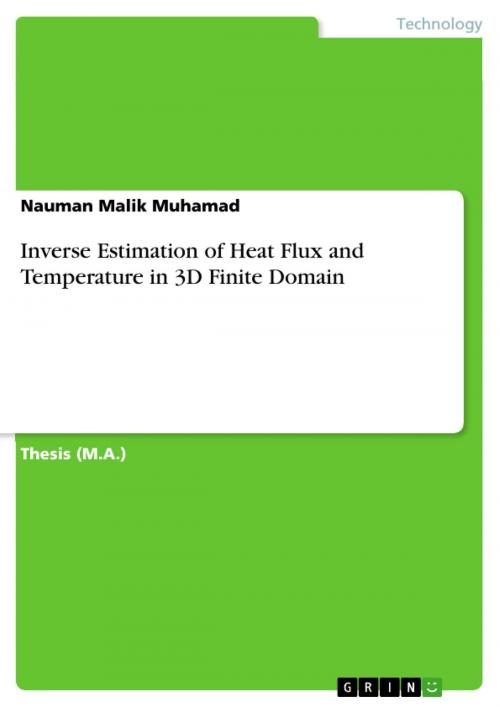Inverse Estimation of Heat Flux and Temperature in 3D Finite Domain
Nonfiction, Science & Nature, Science, Physics, Energy| Author: | Nauman Malik Muhamad | ISBN: | 9783640982585 |
| Publisher: | GRIN Verlag | Publication: | August 12, 2011 |
| Imprint: | GRIN Verlag | Language: | English |
| Author: | Nauman Malik Muhamad |
| ISBN: | 9783640982585 |
| Publisher: | GRIN Verlag |
| Publication: | August 12, 2011 |
| Imprint: | GRIN Verlag |
| Language: | English |
Thesis (M.A.) from the year 2009 in the subject Engineering - Power Engineering, , language: English, abstract: Inverse heat conduction problems occur in many theoretical and practical applications where it is difficult or practically impossible to measure the heat flux generated and the temperature of the layer conducting the heat flux to the body. Thus it becomes imperative to devise some means to cater for such a problem and estimate the heat flux inversely. Adaptive state estimator is one such technique which works by incorporating the semi-Markovian concept into a Bayesian estimation technique thereby developing an inverse input and state estimator consisting of a bank of parallel adaptively weighted Kalman filters. The problem presented in this study deals with a three dimensional system of a cube with one end conducting heat flux and all the other sides are insulated while the temperatures are measured on the accessible faces of the cube. The measurements taken on these accessible faces are fed into the estimation algorithm and the input heat flux and the temperature distribution at each point in the system is calculated. A variety of input heat flux scenarios have been examined to underwrite the robustness of the estimation algorithm and hence insure its usability in practical applications. These include sinusoidal input flux, a combination of rectangular, linearly changing and sinusoidal input flux and finally a step changing input flux. The estimator's performance limitations have been examined in these input set-ups and error associated with each set-up is compared to conclude the realistic application of the estimation algorithm in such scenarios. Different sensor arrangements, that is different sensor numbers and their locations are also examined to impress upon the importance of number of measurements and their location i.e. close or farther from the input area. Since practically it is both economically and physically tedious to install more number of measurement sensors, hence optimized number and location is very important to determine for making the study more application oriented. Before the inverse estimation, a comprehensive mesh sensitivity analysis is given for the system's governing equation finite difference calculations to get an optimized mesh size for the forward and inverse analysis to be correct and within the tolerable error limits and computationally undemanding at the same time.
Thesis (M.A.) from the year 2009 in the subject Engineering - Power Engineering, , language: English, abstract: Inverse heat conduction problems occur in many theoretical and practical applications where it is difficult or practically impossible to measure the heat flux generated and the temperature of the layer conducting the heat flux to the body. Thus it becomes imperative to devise some means to cater for such a problem and estimate the heat flux inversely. Adaptive state estimator is one such technique which works by incorporating the semi-Markovian concept into a Bayesian estimation technique thereby developing an inverse input and state estimator consisting of a bank of parallel adaptively weighted Kalman filters. The problem presented in this study deals with a three dimensional system of a cube with one end conducting heat flux and all the other sides are insulated while the temperatures are measured on the accessible faces of the cube. The measurements taken on these accessible faces are fed into the estimation algorithm and the input heat flux and the temperature distribution at each point in the system is calculated. A variety of input heat flux scenarios have been examined to underwrite the robustness of the estimation algorithm and hence insure its usability in practical applications. These include sinusoidal input flux, a combination of rectangular, linearly changing and sinusoidal input flux and finally a step changing input flux. The estimator's performance limitations have been examined in these input set-ups and error associated with each set-up is compared to conclude the realistic application of the estimation algorithm in such scenarios. Different sensor arrangements, that is different sensor numbers and their locations are also examined to impress upon the importance of number of measurements and their location i.e. close or farther from the input area. Since practically it is both economically and physically tedious to install more number of measurement sensors, hence optimized number and location is very important to determine for making the study more application oriented. Before the inverse estimation, a comprehensive mesh sensitivity analysis is given for the system's governing equation finite difference calculations to get an optimized mesh size for the forward and inverse analysis to be correct and within the tolerable error limits and computationally undemanding at the same time.















